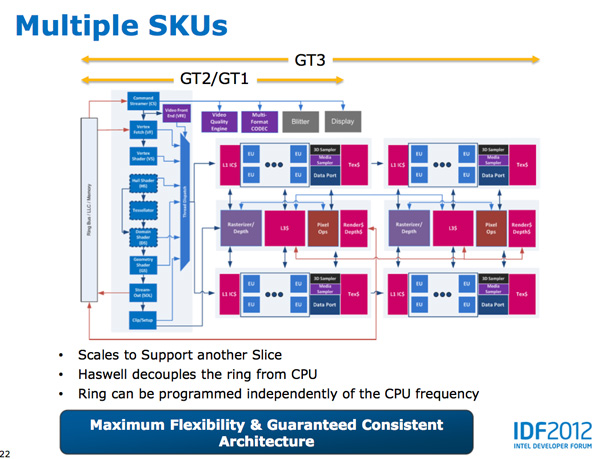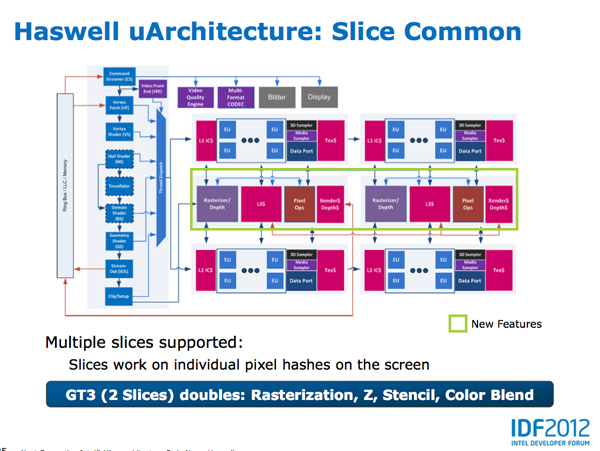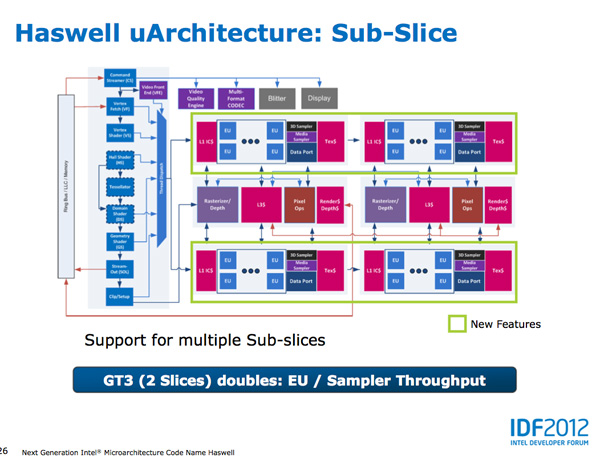Intel's Haswell Architecture Analyzed: Building a New PC and a New Intel
by Anand Lal Shimpi on October 5, 2012 2:45 AM ESTHaswell's GPU
Although Intel provided a good amount of detail on the CPU enhancements to Haswell, the graphics discussion at IDF was fairly limited. That being said, there's still some to talk about here.
Haswell builds on the same fundamental GPU architecture we saw in Ivy Bridge. We won't see a dramatic redesign/re-plumbing of the graphics hardware until Broadwell in 2014 (that one is going to be a big one).
Haswell's GPU will be available in three physical configurations: GT1, GT2 and GT3. Although Intel mentioned that the Haswell GT3 config would have twice the shader count of Haswell GT2, it was careful not to disclose the total number of EUs in any of the versions. Based on the information we have at this point, GT3 should be a 40 EU configuration while GT2 should feature 20 EUs. Intel will also be including up to one redundant EU to deal with the case where there's a defect in an EU in the array. This isn't an uncommon practice, but it does indicate just how much of the die will be dedicated to graphics in Haswell. The larger of an area the GPU covers, the greater the likelihood that you'll see unrecoverable defects in the GPU. Redundancy at the EU level is one way of mitigating that problem.
Haswell's processor graphics extends API support to DirectX 11.1, OpenCL 1.2 and OpenGL 4.0.
At the front of the graphics pipeline is a new resource streamer. The RS offloads some driver work that the CPU would normally handle and moves it to GPU hardware instead. Both AMD and NVIDIA have significant command processors so this doesn't appear to be an Intel advantage although the devil is in the (unshared) details. The point from Intel's perspective is that any amount of processing it can shift away from general purpose CPU hardware and onto the GPU can save power (CPU cores go to sleep while the RS/CS do their job).
Beyond the resource streamer, most of the fixed function graphics hardware sees a doubling of performance in Haswell.
At the shader core level, Intel separates the GPU design into two sections: slice common and sub-slice. Slice common includes the rasterizer, pixel back end and GPU L3 cache. The sub-slice includes all of the EUs, instruction caches and EUs.
In Haswell GT1 and GT2 there's a single slice common, while GT3 sees a doubling of slice common. GT3 similarly has two sub-slices, although once again Intel isn't talking specifics about EU counts or clock speeds between GT1/2/3.
The final bit of detail Intel gave out about Haswell's GPU is the texture sampler sees up to a 4x improvement in throughput over Ivy Bridge in some modes.
Now to the things that Intel didn't let loose at IDF. Although originally an option for Ivy Bridge (but higher ups at Intel killed plans for it) was a GT3 part with some form of embedded DRAM. Rumor has it that Apple was the only customer who really demanded it at the time, and Intel wasn't willing to build a SKU just for Apple.
Haswell will do what Ivy Bridge didn't. You'll see a version of Haswell with up to 128MB of embedded DRAM, with a lot of bandwidth available between it and the core. Both the CPU and GPU will be able to access this embedded DRAM, although there are obvious implications for graphics.
Overall performance gains should be about 2x for GT3 (presumably with eDRAM) over HD 4000 in a high TDP part. In Ultrabooks those gains will be limited to around 30% max given the strict power limits.
As for why Intel isn't talking about embedded DRAM on Haswell, your guess is as good as mine. The likely release timeframe for Haswell is close to June 2013, there's still tons of time between now and then. It looks like Intel still has a desire to remain quiet on some fronts.














245 Comments
View All Comments
dishayu - Friday, October 5, 2012 - link
I derived immense pleasure reading the article. Thank you, Anand. Big ups for the comprehensive read.My thoughts :
I think Intel really dropped the ball by not having unlinked clocks for each core, like qualcomm has for it's s4 pro processors. There are so many times that, for instance, i have a page open with some animated GIFs. They are strictly single thread processes and they won't let the processor go to idle state. And this is a very VERY common occurance that can IMO, only be solved by adopting unlocked states for each core. 3 cores can stay in sleep state (almost perpetually) and the processor runs on a single core with lowered frequency. THAT would be power efficient.
dagamer34 - Friday, October 5, 2012 - link
Uhh... isn't turning off unused cores and overclocking the 4th core within TDP to perform single threaded tasks exactly what Turbo Boost introduced in Sandy Bridge is?know of fence - Friday, October 5, 2012 - link
Reducing power is great and also inevitable, but Intel's move to compete against everything and everybody is alarming. With everyone trying to follow/please Apple, that means nothing good for the consumer, throw-away luxury electronics for exceptionally well groomed masses.Also, isn't it too early to be hyping this stuff?
A5 - Friday, October 5, 2012 - link
Intel has to compete against ARM to keep them from taking over the "good-enough" computing space.As for the rest of it, you're not making any sense.
jjj - Friday, October 5, 2012 - link
The ARM problem is not about the product but about price, long term the CPU/SoC ASP will drop hard ,there is competition now. Servers will keep them on life support for a while but without fundamental changes to their business model they can't make it.Intel should remember how they won the market .
dishayu - Friday, October 5, 2012 - link
It's about both. Intel does not have sufficinetly low power parts at all, regardless the price point.mrdude - Friday, October 5, 2012 - link
Regardless of whether they step foot into that end of the spectrum or not (and by Anand's analysis that's more likely with Broadwell and on?), they still need to compete on price.It's one thing to make a chip, it's quote another to make it competitive with respect to pricing. What works against a distant AMD won't work against ARM.
DesDizzy - Sunday, October 7, 2012 - link
I agree. This seems to be something that most people overlook when addressing the Wintel monopoly. The costs of Wintel products are high within the PC/Laptop space. The price of ARM/Apps are cheap within the Smartphone/Tab space. How do Wintel square this circle without damaging their business model?Krysto - Friday, October 5, 2012 - link
You may not agree with Charlie, Anand, but reality seems to agree with him:http://www.techradar.com/news/computing/apple/appl...
I really don't know how you can think Apple would ever start using Intel chips in their iPads when Apple has already proven they want to make their own chips with A6.
Also, according to Charlie, Haswell will be like 40% more expensive than IVB. Atom tablets already seem to start at like $800. So I wish Intel good luck with that. Ultrabooks and Win8 hybrids won't drop down in price any time soon.
http://semiaccurate.com/2012/10/03/oems-call-intel...
Penti - Friday, October 5, 2012 - link
I don't know how you could fail so much in reading comprehension, Anand only said the same flying spaghetti monster-damn form factor. Nothing else. There also must be an ecosystem, but if you can run the same app on a tablet as well as a desktop on x86 with more performance then ARM why wouldn't you see vendors use it. It is a full system even capable of building itself. It's not about killing ARM. Intel still uses it, they need fairly high-performance RISC chips for stuff like baseband. They had a large markets in smart-phones before 2006 and they made the choice to sell it because they had Atom in their lineup. They didn't forget about it.It's Microsoft tablets that costs 500-900 dollars even on Atom, but they only need to compete with Windows RT which is totally retarded as far as corporate customers go and not the same system as 8 Pro, doesn't run the same software. An Android tablet could use a Z2460 (and coming Z2580, after that Valleyview SoC's) and build a 240 dollar tablet. There is no price difference to be had as far as hardware is concerned. Windows 8 tablets are a whole other form factor and device to begin with. Most will have keyboard and multitouch trackpad.
He only talks about the same form factor, size and battery life here. In the Microsoft ecosystem there is really no reason to go to Windows RT powered ARM-devices which doesn't have better performance and runs no third party desktop (Win32/Full Windows SDK) software. It also lacks the same features in other areas which makes them devices instead of general computing platforms. Remember they offer both here. Hell the built in email is even worse then the one built into Android since version 3.0 or so, it's a lot worse then Third party mail-clients in Android, it's worse then mail-clients in Blackberry 10, Symbian, iOS and so on. If your replacing a desktop your not going with ARM here, not on a Windows device at least, Anand only talks about a new bread of DTR Tablets and Ultra-portables that will fit in the same form factor and battery life scenarios as ARM-tablets. Apple certainly don't need to participate here.
Intel certainly has sales to be made if they move Haswell down to low-power Atom territory when it comes out later next year. They could be used as the only computing device you have (smartphone + hybrid tablet-pc). Replacing desktops, ARM/ATOM-tablets, media PCs for your TV (just stream with Miracast). Et cetera. ARM-devices would just be cheaper less capable devices there. But it's still different targets. Haswell still targets server (enterprise-market), desktop, notebooks with larger form-factor/power-usage, as well as more portable stuff. Atom is still for the handheld stuff you use with one hand. ARM has moved quiet fast but they have no reason to target high-performance applications or built 100W SoC's that is fast without parallel computing. Applications like high-performance routers for example still uses licensed and custom MIPS and PowerPC chips. There are plenty of markets where a full feature ARM Cortex or x86 won't work either. ARM is just moving into the multimedia-field, replacing customs architectures in TV's, displacing MIPS, PPC etc. If Apple builds a very large custom CPU-architecture compatible with ARM ISA for workstations, notebooks etc they will just be in the same position they were with PowerPC and have to compete with the high-performance chips that most can't compete with, even with much larger resources then Apple. Apple and Samsung has no reason in doing so outside handheld devices, low-power servers, consumer oriented routers, streaming media boxes which leaves plenty of room for Intel and all the rest. Plus WiFi and wireless baseband in a huge market in of it self and it doesn't matter what the application processor architecture is. Stuff like ARM has competed because you could replace previous products with it easily, thus taking some of the SoC-market away from other, but that coincides with the choice to do so.